Shopping Cart
Remove All Your shopping cart is currently empty
Your shopping cart is currently empty
Anti-ATP7A Polyclonal Antibody is a Rabbit antibody targeting ATP7A. Anti-ATP7A Polyclonal Antibody can be used in FCM,IF,IHC-Fr,IHC-P.
| Pack Size | Price | USA Warehouse | Global Warehouse | Quantity |
|---|---|---|---|---|
| 50 μL | $222 | 7-10 days | 7-10 days | |
| 100 μL | $374 | 7-10 days | 7-10 days | |
| 200 μL | $528 | 7-10 days | 7-10 days |
| Description | Anti-ATP7A Polyclonal Antibody is a Rabbit antibody targeting ATP7A. Anti-ATP7A Polyclonal Antibody can be used in FCM,IF,IHC-Fr,IHC-P. |
| Synonyms | OHS, MNK, MK, Menkes syndrome, Menkes disease-associated protein, MC1, MC 1, Cu++transporting P type ATPase, Copper transporting ATPase 1, Copper pump 1, ATPase Cu++transporting alpha polypeptide(Menkes syndrome), ATPase Cu++transporting alpha polypeptide, ATPase Copper Transporting alpha Polypeptide, ATP7A, ATP 7A |
| Ig Type | IgG |
| Reactivity | Human,Mouse,Rat (predicted:Dog,Cow,Horse,Rabbit) |
| Verified Activity | 1. Blank control: U-2OS. Primary Antibody (green line): Rabbit Anti-ATP7A antibody (TMAB-00170) Dilution: 2 μg/10^6 cells; Isotype Control Antibody (orange line): Rabbit IgG. Secondary Antibody: Goat anti-rabbit IgG-PE Dilution: 1 μg/test. Protocol The cells were fixed with 4% PFA (10 min at room temperature) and then permeabilized with 0.1% PBST for 20 min at room temperature. The cells were then incubated in 5% BSA to block non-specific protein-protein interactions for 30 min at room temperature. Cells stained with Primary Antibody for 30 min at room temperature. The secondary antibody used for 40 min at room temperature. 2. Paraformaldehyde-fixed, paraffin embedded (Rat brain); Antigen retrieval by boiling in sodium citrate buffer (pH6.0) for 15 min; Block endogenous peroxidase by 3% hydrogen peroxide for 20 min; Blocking buffer (normal goat serum) at 37°C for 30 min; Antibody incubation with (ATP7A) Polyclonal Antibody, Unconjugated (TMAB-00170) at 1:400 overnight at 4°C, followed by operating according to SP Kit (Rabbit) instructionsand DAB staining. 3. Paraformaldehyde-fixed, paraffin embedded (Mouse brain); Antigen retrieval by boiling in sodium citrate buffer (pH6.0) for 15 min; Block endogenous peroxidase by 3% hydrogen peroxide for 20 min; Blocking buffer (normal goat serum) at 37°C for 30 min; Antibody incubation with (ATP7A) Polyclonal Antibody, Unconjugated (TMAB-00170) at 1:400 overnight at 4°C, followed by operating according to SP Kit (Rabbit) instructionsand DAB staining. 4. Paraformaldehyde-fixed, paraffin embedded (Human brain glioma); Antigen retrieval by boiling in sodium citrate buffer (pH6.0) for 15 min; Block endogenous peroxidase by 3% hydrogen peroxide for 20 min; Blocking buffer (normal goat serum) at 37°C for 30 min; Antibody incubation with (ATP7A) Polyclonal Antibody, Unconjugated (TMAB-00170) at 1:400 overnight at 4°C, followed by operating according to SP Kit (Rabbit) instructionsand DAB staining. 5. Paraformaldehyde-fixed, paraffin embedded (mouse heart); Antigen retrieval by boiling in sodium citrate buffer (pH6.0) for 15 min; Block endogenous peroxidase by 3% hydrogen peroxide for 20 min; Blocking buffer (normal goat serum) at 37°C for 30 min; Incubation with (P7A) Polyclonal Antibody, Unconjugated (TMAB-00170) at 1:200 overnight at 4°C, followed by operating according to SP Kit (Rabbit) instructionsand DAB staining. 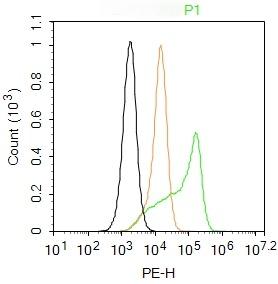 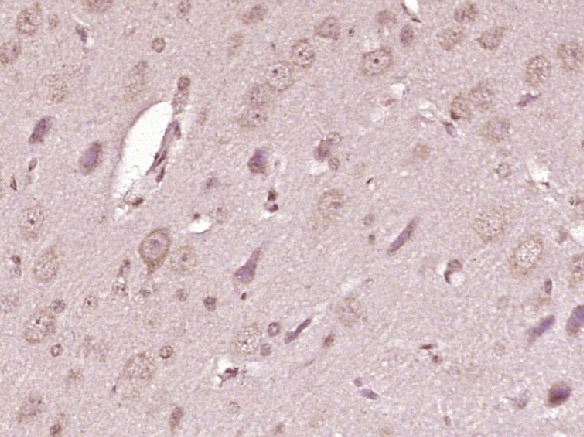 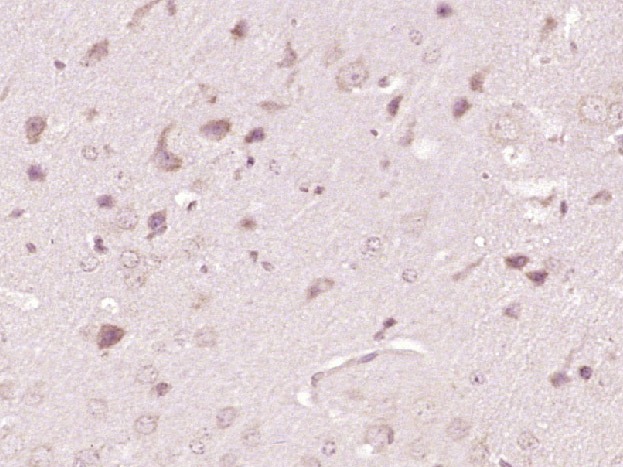 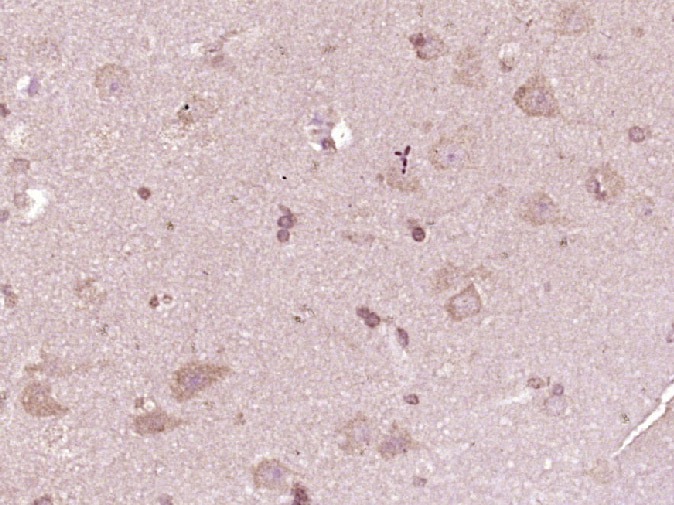 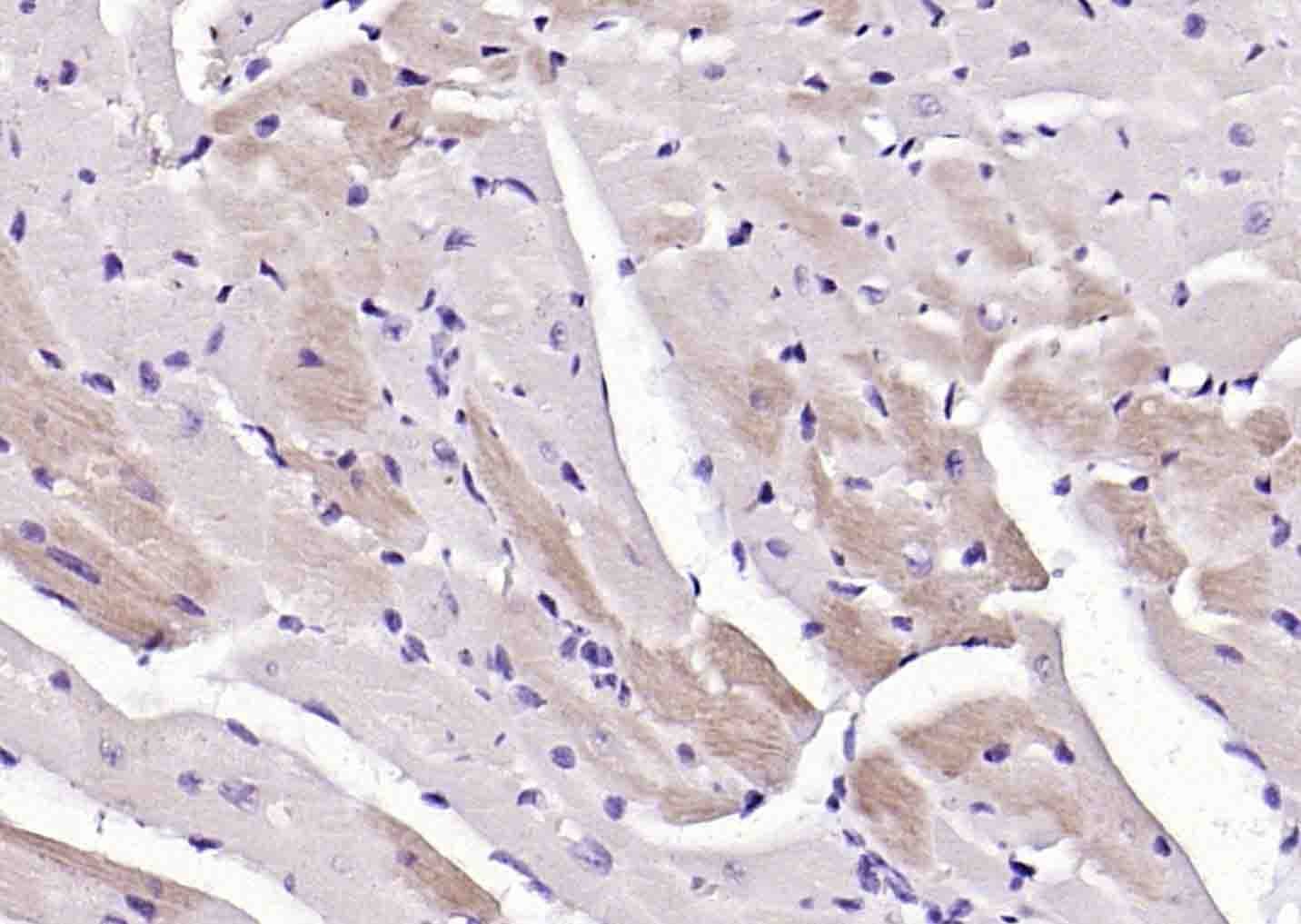 |
| Application | |
| Recommended Dose | IHC-P: 1:100-500; IHC-Fr: 1:100-500; IF: 1:100-500; FCM: 2ug/Test |
| Antibody Type | Polyclonal |
| Host Species | Rabbit |
| Subcellular Localization | Golgi apparatus. trans-Golgi network membrane; Multi-pass membrane protein. Cell membrane; Multi-pass membrane protein. Note: Cycles constitutively between the trans-Golgi network (TGN) and the plasma membrane. Predominantly found in the TGN and relocalized to the plasma membrane in response to elevated copper levels. Isoform 3: Cytoplasm. cytosol. Isoform 5: Endoplasmic reticulum. |
| Tissue Specificity | Found in most tissues except liver. Isoform 3 is widely expressed including in liver cell lines. Isoform 1 is expressed in fibroblasts, choriocarcinoma, colon carcinoma and neuroblastoma cell lines. Isoform 2 is expressed in fibroblasts, colon carcinoma a |
| Construction | Polyclonal Antibody |
| Purification | Protein A purified |
| Appearance | Liquid |
| Formulation | 0.01M TBS (pH7.4) with 1% BSA, 0.02% Proclin300 and 50% Glycerol. |
| Concentration | 1 mg/mL |
| Research Background | Copper-transporting ATPase 1 is an integral membrane protein cycling constitutively between the trans-golgi network and the plasma membrane. It may supply copper to copper-requiring proteins within the secretory pathway, when localized in the trans-golgi network. Under conditions of elevated extracellular copper, it relocalized to the plasma membrane where it functions in the efflux of copper from cells. Defects in ATP7A are the cause of Menkes syndrome; also known as kinky hair disease, an X-linked recessive disorder. |
| Immunogen | KLH conjugated synthetic peptide: human ATP7A |
| Antigen Species | Human |
| Gene Name | ATP7A |
| Gene ID | |
| Protein Name | Copper-transporting ATPase 1 |
| Uniprot ID | |
| Biology Area | Vitamins / minerals,Neurodegenerative disease,ATPases,Vitamins / Minerals |
| Function | May supply copper to copper-requiring proteins within the secretory pathway, when localized in the trans-Golgi network. Under conditions of elevated extracellular copper, it relocalized to the plasma membrane where it functions in the efflux of copper from cells. |
| Molecular Weight | Theoretical: 163 kDa. |
| Stability & Storage | Store at -20°C or -80°C for 12 months. Avoid repeated freeze-thaw cycles. |
| Transport | Shipping with blue ice. |
| Size | Quantity | Unit Price | Amount | Operation |
|---|

Copyright © 2015-2025 TargetMol Chemicals Inc. All Rights Reserved.